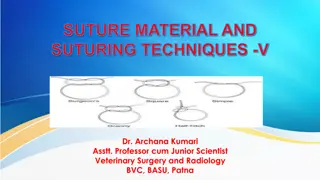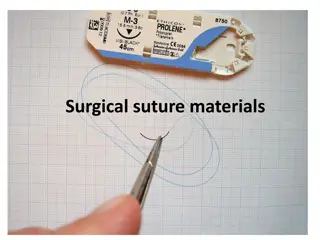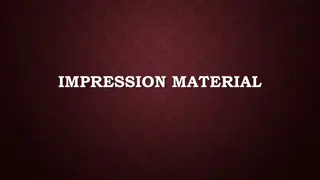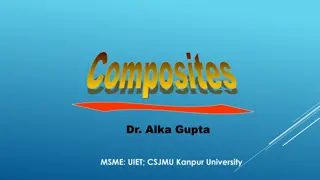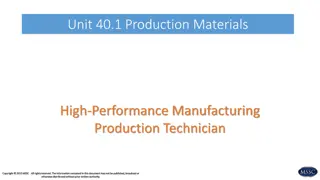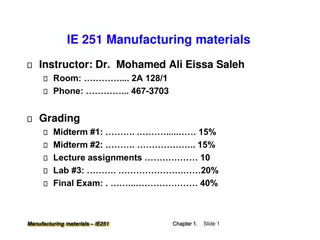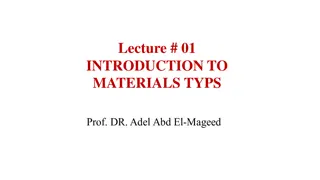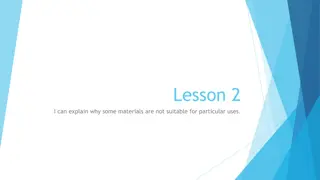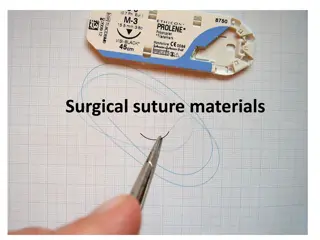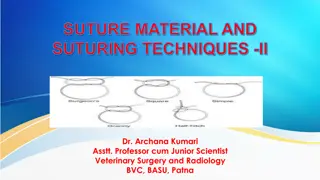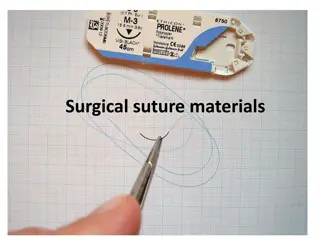Suture Materials
Surgical suture materials play a crucial role in wound closure, with various types like absorbable, nonabsorbable, natural, and synthetic. Learn about their classifications and properties, aiding in the healing process and tissue recovery post-surgery.
Download Presentation

Please find below an Image/Link to download the presentation.
The content on the website is provided AS IS for your information and personal use only. It may not be sold, licensed, or shared on other websites without obtaining consent from the author.If you encounter any issues during the download, it is possible that the publisher has removed the file from their server.
You are allowed to download the files provided on this website for personal or commercial use, subject to the condition that they are used lawfully. All files are the property of their respective owners.
The content on the website is provided AS IS for your information and personal use only. It may not be sold, licensed, or shared on other websites without obtaining consent from the author.
E N D
Presentation Transcript
StudyMafia.Org Suture Materials Submitted To: Studymafia.org Studymafia.org Submitted By:
Table of Content What is Suture Classification of sutures Types of Suture Techniques How to make a surgical incision How to bury a knot Intradermal suture patterns How to perform an Aberdeen knot Conclusion
What is Suture Surgical suture materials are used in the closure of most wound types. The ideal suture should allow the healing tissue to recover sufficiently to keep the wound closed together once they are removed or absorbed. The time it takes for a tissue to no longer require support from sutures will vary depending on tissue type: Days: Muscle, subcutaneous tissue or skin Weeks to Months: Fascia or tendon Months to Never: Vascular prosthesis
Absorbable suture materials Definition: Materials that lose significant tensile strength within 60 days of being placed in tissue arbitrary 60-day time frame refers to loss of strength NOT disappearance from the tissue. Some absorbable materials are physically present a long time but have no appreciable strength. suture is broken down by phagocytosis or hydrolysis
Nonabsorbable suture materials Definition: materials that maintain their tensile strength in tissue at least 60 days some lose strength over prolonged periods (eg. silk) others maintain original strength and are walled off by fibrous tissue can be permanently buried in tissues when necessary monofilament form preferred as associated with fewer infections avoid burying multifilament nonabsorbable sutures (associated with infection and draining tracts)
Natural suture materials made of natural fibers are absorbable or nonabsorbable types tend to induce more tissue reaction than synthetic materials common examples include surgical gut (catgut) and silk
Synthetic suture materials made of man-made materials are absorbable or nonabsorbable types tend to be less reactive than natural materials tend to lose tensile strength and be absorbed at more predictable rates common examples include polydioxanone (PDS) and nylon
Monofilament sutures Consists Of A Single Strand Of Material Has Minimal Tissue Drag Decreased Knot Security Because Of Smoothness So Additional Throws Are Needed To Achieve Secure Knots Significantly Weakened By Kinking Or If Crushed By Instruments.
Multifilament (braided) sutures Consists Of Several Fibers Twisted Or Braided Into A Single Strand Generally Stronger Usually Better Knot Security More Tissue Drag Many Available With Coatings Applied By Manufacturer To Minimize Tissue Drag But Also Decreases Knot Security
Types of Suture Techniques Continuous Suture A continuous Suture is a surgical technique which involves several stitches wherein the doctor uses a single strand of the suture thread material. This technique is applied rapidly while placing a suture. It is also strong as it allows the tension to be evenly distributed throughout the suture strand. Interrupted Sutures The interrupted suture is a technique that uses many strands of the suture material in order to close a wound. Once the stitch is made, the doctor cuts off and ties the material. The interrupted suture technique enables the doctor to close the wound so securely that even if one stitch breaks, the remaining ones can still hold the wound together
Types of Suture Techniques Deep Sutures Yet another type of surgical suture technique is the deep suture technique. Here, the doctor places the suture under the tissue layers, which are deep below the skin. The sutures can be either interrupted or continuous and are often used in procedures in which the facial layer has to be closed. Buried Sutures The buried suture technique is applied by doctors such that the suture knot is found inside, i.e. within or under the area that has to be closed off. This type of surgical suture is not removed typically. It is often useful when large sutures are used in the deeper corners of the body.
Types of Suture Techniques Purse String sutures A type of continuous suture, the purse-string suture is placed around the infected area. It is typically tightened in a pattern that resembles a drawstring attached to a bag. This suturing technique is used to reduce the surface area of a circular wound, with the aim of obtaining minimal scarring. A Subcuticular Suture The suture that is usually placed in the patient s dermis, i.e. the layer of tissue which lies below the skin s upper layer, is known as the subcutaneous suture. In this type of suture, the doctor places short stitches in a line, parallel to the wound. The doctor also anchors the stitches on either end of the wound.
How to bury a knot This technique is used to start a line of subcutaneous or intradermal sutures to reduce the irritation that may be caused by the knots rubbing against superficial tissues. To bury the knot, introduce the needle deep in the far subcutaneous or intradermal tissue passing it up into the tissue, across the incision and then down into the tissue on the near side exiting deep in the incision line. Now form a knot, which will be buried within the incision line.
Intradermal Suture Pattern Often used to replace skin sutures and reduce scarring Reduce patient interference and eliminate the need for suture removal in sensitive areas or in fractious patients Started by burying the knot Bites of the suture lie parallel to the line of the incision Successive bites should backtrack slightly for the best apposition Tension is adjusted after each bite as it is difficult to readjust once the pattern is completed Suture line is completed with another buried knot or Aberdeen knot Absorbable suture material should be used
How to perform an Aberdeen knot (A) The hand picks up the last suture loop placed through the wound and the fingers are slipped through it. (B) The middle and ring fingers are hooked around the suture attached to the needle, which is maintained in traction and pulled back through the loop. (C) Steps 1, 2: The loop is allowed to slip off the thumb so the hitch is formed. (D) Tightening of hitch is facilitated by hooking the ring and little finger through the loop and exerting traction in the direction of the arrow while relaxing tension on the suture and needle holders (the first throw is now complete). Steps A through the D are repeated 2 or more times to add additional throws. (E) To place the final locking throw (called a turn), instead of holding onto the needle it is allowed to pass through the loop and continued traction tightens and locks the Aberdeen knot.
Conclusion Sutures are used by your doctor to stitch shut wounds or lacerations. There are many different types of suture materials available. Additionally, there are many suture techniques that can be used. Your doctor will choose both the correct suture material and technique to use for your condition. Talk to your doctor about any concerns you have about sutures before your procedure.
References Google.com Wikipedia.org Studymafia.org Slidespanda.com
Thanks To StudyMafia.org




